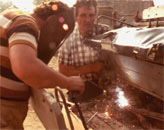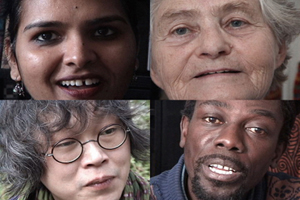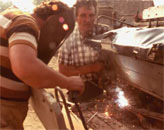Part of Winter 2005
Pleasure Dome is pleased to host Phill Niblock and Katherine Liberovskaya on their Toronto stop of a Canadian concert tour. Their unique intermedia events integrate their groundbreaking work in film, video and music. With video digitally projected onto multiple screens and their musical compositions surging from a quadraphonic sound system, this event will transform the Latvian Hall into a stage for this work of shimmering beauty, methodical detail and staggering scale.
The films of Phill Niblock are stunningly beautiful distillations of his creative sensibilities. Filmed on Kodachrome 16mm during the 70s and 80s, his series “looking at the movement of people working” is an exhaustive document of physical labour. Over those two decades, he traveled to agrarian areas in many nations (Hong Kong, Peru, Mexico, Hungary, and more) to compose long studies of movement. Unlike an anthropological study, Niblock’s films abstract themselves down to the level of motion, focusing on the qualities of repetitive movement, “the texture of rhythm and form of body motion within the frame.”
A typical Niblock concert uses these films to create a visual rhythm to the shimmering overtones that he produces from his musical compositions. Niblock’s music is probably the better-known half of his creative output. A rogue contemporary of the New York minimalist scene of the late 60s and early 70s, his uncompromising work has inspired the next generation of drone explorers, including Jim O’Rourke, Sonic Youth, Rafael Toral and Kevin Drumm. Niblock builds his music from multiple tracks of tightly controlled microtonal intervals. The resulting drone, played back at high volume, creates a wall of sound, with the organic sounds of the acoustic instruments suspended in a ceiling of sparkling overtones. At once physical and compellingly meditative, these performances are a unique blend of visual and aural interplay. Niblock will be joined by artist/musician Matt Rogalsky from Kingston to interpret his work for this performance.
Opening the evening, Liberovskaya and Niblock with present their work-in-progress Babel-On, a five channel video-audio installation/performance. The first collaboration between Niblock and Montreal video/multimedia artist Katherine Liberovskaya features sync-sound video by Liberovskaya and sound by Niblock. The new work explores the melodic and rhythmical dimensions of human spoken languages as musical instruments of communication and concentrates on the sound of verbal expression rather than on its meaning.
Phill Niblock + Katherine Liberovskaya | Babel-On
A five channel video-audio installation/performance work-in-progress
Sync-sound video: Katherine Liberovskaya
Sound piece: Phill Niblock
The first collaboration between New York intermedia artist/composer Phill Niblock and Montreal video/multimedia artist Katherine Liberovskaya, Babel-On is a sound based audio-video exploring the melodic and rhythmical dimensions of human spoken languages as musical instruments of communication and concentrates on the sound of verbal expression rather than on its meaning.
The three simultaneous projections display different successions of video clips of a wide variety of very tight shots of the faces of women and men of different nationalities and/or origins speaking in their mother-tongues about the musical rhythmical properties and idiosyncrasies of their respective languages as well as strive to remember tongue twisters or rhymes. In counterpoint to these video projections with their sync sound, concurrently plays a sound composition, derived from voices and languages, by Phill Niblock. Constructed from the actual utterances in the video footage, this thick, numerous track, composition forms an acoustic environment that interacts with the multilingual speech, at times accompanying it, at others overriding and replacing it, at still other times growing silent, thus creating a sonic conversation of sorts.
Babel-On is meant to create a very physical, living audio-video flow of variations of associations and dissociations, of different tensions, between image and sound, speech and music, words and significations, intention and chance, a constant flux of unstable, slipping, shifting meanings and perceptions. It is an experiential piece that evokes the nonverbal possibilities of vocal communication, suggesting various relationships between diverse geopolitical regions, cultural traditions and civilizations.
intermission
Phill Niblock | The Movement of People Working
Film and Music by Phill Niblock with guest guitarist Matt Rogalsky
Film:
1. Sur Dos (Peru)
2. Trabajando Una (Mexico)
3. Sur Una (Mexico)
4. Trabajando Dos (Mexico)
5. Hong Kong
6. Hungary
(total time 2 hours, 2 minutes)
Music:
Hurdy Hurry (15:00 min., 1999) Jim O’Rourke, hurdy gurdy samples
Sethwork (22:00 min., 2003) Seth Josel, unamplified guitars played with e-bow, recorded samples
Matt Rogalsky, playing guitar live
Harm, for cello (22:00 min., 2003) Arne Deforce, cello, recorded samples
Zrost (23:30 min., 2004) Martin Zrost, soprano saxophone, recorded samples
Guitar two, for four for electric guitars played with e-bows; original samples by: Rafael Toral, Robert Poss, Susan Stenger, David First; with added parts by Kevin Drumm, Lee Ranaldo, Thurston Moore, Alan Licht, Robert Poss
Matt Rogalsky, playing guitar live
These 16mm films (projected from DVD video), 1.-4., were made in 1973/74. Three of them were made in Mexico, one in Peru. They were printed on Kodachrome print stock from a reversal original. These were the first films of the series “looking at the movement of people working.”
Sur Una and Dos (Mexico and Peru, respectively) are concentrated on the movement of people’s hands. Most of the activities are agrarian, some are crafts &lrquo;” weaving, etc. In Trabajando Una and Dos, I was looking at more general work movement. These films are combined with four channel music pieces from roughly the same period.
5. Hong Kong and 6. Hungary simply have the names of the countries where the film was shot. Hong Kong was filmed in 1978, Hungary in 1985. The music was made between 1975 and 1983. In Hong Kong, I filmed in many communities on the main island, and some on outlying islands, also in Macau. I was accompanied by members of the Phoenix Cine Club. In Hungary I filmed in two communities – Gonc, near Slovakia, and Milota, on the Tisza River.
Katherine Liberovskaya is a Montreal-born multidisciplinary artist who has been working predominantly in experimental video and digital media since the late eighties. Over the years, she has produced many single-channel videos and installation works, some of which have earned awards and mentions in Europe and North America. Her articles have been published in ESSE-Arts + Opinions, la Revue Electronique du CIAC, the Banff Center’s HorizonZero and the Canadian Journal of Communication. Moreover, in addition to her art practice she has concurrently been involved in the programming and organization of diverse media art events, notably in recent years with Studio XX (of which she was programming coordinator from 1996-98 and president from 2001 to 2003) and Espace Videographe. liberovskaya@compuserve.com
Phill Niblock is an intermedia artist using music, film, photography, video and computers. He makes thick, loud drones of music, filled with microtones of instrumental timbres which generate many other tones in the performance space. Simultaneously, he presents films/videos which look at the movement of people working, or computer driven black and white abstract images floating through time. He was born in Indiana in 1933. Since the mid-60’s he has been making music and intermedia performances which have been shown at numerous venues around the world. Since 1985, he has been the director of the Experimental Intermedia Foundation in New York www.experimentalintermedia.org where he has been an artist/member since 1968. He is the producer of Music and Intermedia presentations at EI since 1973 (about 1000 performances) and the curator of EI’s XI Records label. In 1993 was formed an Experimental Intermedia organization in Gent, Belgium – EI v.z.w. Gent – to support the artist-in-residence house and installations there. Phill Niblock’s music is available on the XI, Moikai, Mode and Touch labels. A DVD of films and music is available on the Extreme label. pniblock@compuserve.com


